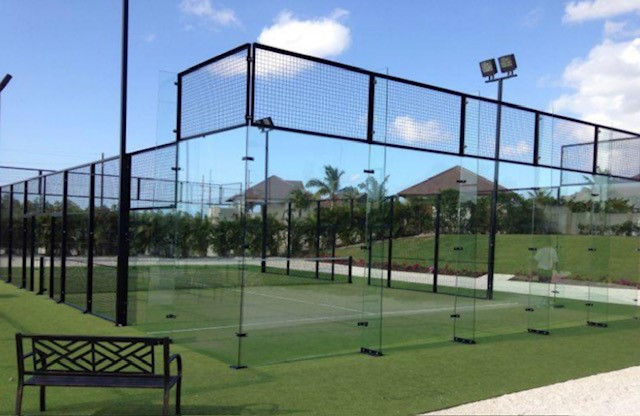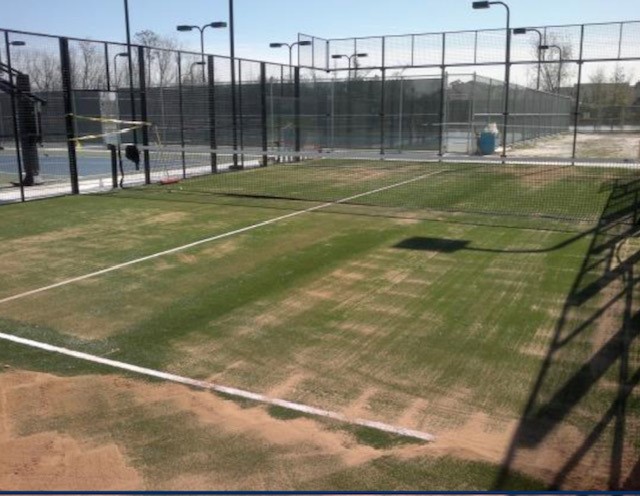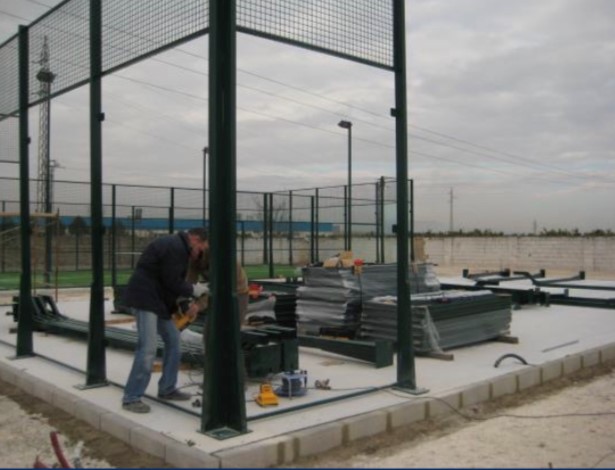Menu

Padel, a captivating blend of tennis and squash, is not just a game – it's an experience that brings people together. Known for its quick learning curve, Padel is perfect for anyone eager to dive into a new sport without the steep learning challenges often found in traditional tennis. Padel has been gaining popularity for its accessibility and fun gameplay.
Our expertise in sports court installation positions us perfectly to bring this growing sport to your community, school, club, or backyard. Padel is a game that captivates all ages and skill levels, renowned for its ease of learning and social nature. Unlike tennis, where strength and technique are paramount, Padel levels the playing field, making it ideal for mixed play among men, women, and youth.
Originating in Mexico and wildly popular in Spain and Latin America, Padel is a sport that combines the best elements of tennis and squash. It's played on an enclosed court about a third smaller than a tennis court, with similar scoring and balls. However, what sets Padel apart are its unique features: the court has walls, and the balls can be played off these walls, similar to squash.
The rackets used in Padel are solid and stringless, differing significantly from tennis rackets. This distinctive equipment, combined with the smaller court size and wall play, makes Padel an engaging and accessible sport. The learning curve for Padel is notably gentle. Most players grasp the basics within the first 30 minutes, allowing them to quickly engage in the fun and competitive aspects of the game.
Padel is not just about physical prowess; it's a sport where strategy plays a key role. The enclosed court changes the dynamics of the game, making it more about skillful play and less about power. This aspect makes Padel an inclusive sport, suitable for all genders and ages, and perfect for families, friends, and communities to come together.


When considering the addition of sports facilities for parks and recreation areas, HOAs, or schools, the choice between installing a tennis court or Padel courts is significant. At AG Sports Surfaces, we understand this decision's impact and are here to outline the benefits of choosing Padel courts over traditional tennis courts.
Space Efficiency: One of the most striking advantages of Padel courts is their space efficiency. A standard tennis court covers a playing surface of 7,200 square feet. In contrast, a Padel court requires just 2,178 square feet. This smaller size means that in the same area occupied by one tennis court, you could fit three Padel courts, maximizing your space utilization.
Cost-Effectiveness: Financial considerations are always paramount. The average cost of installing a single tennis court is around $65,000. However, for just $80,000, you can install three Padel courts.
Increased User Capacity: When it comes to accommodating players, Padel courts offer superior capacity. A tennis court can service four players at a time. In contrast, with three Padel courts, up to 12 players can enjoy the game simultaneously. This increased capacity is especially beneficial for community centers, schools, and residential communities, ensuring that more people can engage in physical activity and social interaction at the same time.
Accessibility and Appeal: Padel is known for being easier to learn and play compared to tennis. This accessibility makes it an attractive option for a wider range of age groups and skill levels
A standard Padel court is 65.6 feet long and 32.8 feet wide. This size is quite compact compared to a tennis court, making it an efficient use of space while still offering ample room for dynamic play. This space-efficient design is ideal for those looking to maximize their recreational area.
A Padel court requires a clear overhead space of at least 20 feet from the lowest point of the court. This height ensures that the ball can be played freely without any obstructions, enhancing the quality of the game.
The sidewalls at both ends of a Padel court are typically designed as stepped walls, consisting of two panels. The first panel, connecting with the back wall, stands at a height of 13 feet. The second panel, continuing from the first, has a height of 10 feet. In another variation, the sidewall can run at a continuous height of 13 feet from one back wall to the other. This design offers a different dynamic to the game, with longer walls for ball rebound.
The net in a Padel court is similar in appearance to a tennis net but with specific dimensions suited for Padel. It stretches across the middle of the court, dividing it into two equal halves. The net is 33 feet long, matching the width of the Padel court. At the center, the net is 34 inches high, and at the posts, it is slightly higher, measuring 36.
A natural grass surface on a Padel court offers a traditional look and a softer playing experience, which is easier on players' joints and muscles. The ball moves slower on grass, affecting the style of play and leading to longer rallies. However, maintaining a natural grass surface requires regular watering, mowing, and fertilizing to keep it in optimal condition.
A synthetic surface for your Padel court, similar to those used in tennis courts, provides a durable and consistent playing surface. These surfaces are engineered to endure heavy usage and diverse weather conditions, ensuring a long-lasting playing field. The nature of synthetic surfaces lends itself to a faster-paced game compared to grass, characterized by a higher ball bounce. One of the key benefits of choosing a synthetic surface is its low maintenance requirements. Unlike natural grass, synthetic surfaces demand minimal upkeep and are less prone to natural wear and tear, making them a practical and efficient option for your Padel court.

A natural grass surface on a Padel court offers a traditional look and a softer playing experience, which is easier on players' joints and muscles. The ball moves slower on grass, affecting the style of play and leading to longer rallies. However, maintaining a natural grass surface requires regular watering, mowing, and fertilizing to keep it in optimal condition.
A synthetic surface for your Padel court, similar to those used in tennis courts, provides a durable and consistent playing surface. These surfaces are engineered to endure heavy usage and diverse weather conditions, ensuring a long-lasting playing field. The nature of synthetic surfaces lends itself to a faster-paced game compared to grass, characterized by a higher ball bounce. One of the key benefits of choosing a synthetic surface is its low maintenance requirements. Unlike natural grass, synthetic surfaces demand minimal upkeep and are less prone to natural wear and tear, making them a practical and efficient option for your Padel court.
Explore the exciting world of Padel with AG Sports Surfaces. Whether it's for a parks and recreation, school, HOA, or your backyard, we're here to deliver a top-quality Padel court tailored to your space and preferences. Our expert team is ready to guide you through every step, ensuring a seamless and customized installation.
Contact us today for a comprehensive site evaluation and a free estimate. Let AG Sports Surfaces bring the dynamic and fast-growing sport of Padel to your doorstep.
Please complete the form below for a free no-obligation estimate.